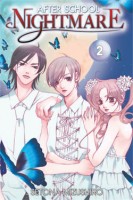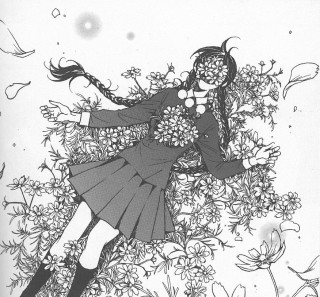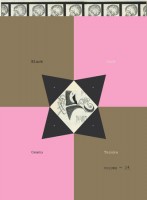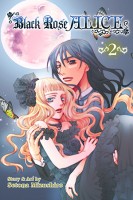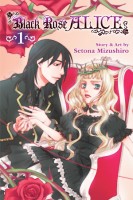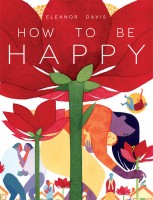My News and Reviews
And the honor of the first in-depth manga review for the month of March at Experiments in Manga goes to Tetsu Kariya and Akira Hanasaki’s Oishinbo, A la Carte: Vegetables which, as is probably fairly obvious, is a food manga about vegetables. I tend to enjoy the Oishinbo, A la Carte collections, finding them to be both educational and entertaining. Vegetables is a good volume, but it does get pretty political. I also posted a list of manga featuring immortals last week as part of the announcement of the UQ Holder! Giveaway Winner. February’s Bookshelf Overload was posted as well, which can mostly be summarized by me yelling “JooooooJoooooo!”
I was fairly busy last week, but a few things did catch my eye online. Viz Media’s Shojo Beat imprint announced two new licenses: Bloody Mary by Akaza Samamiya and Honey So Sweet by Amu Meguro. Seven Seas had a pretty big surprise, too—it’s opened a division focused on producing anime and manga themed tabletop games. First up? A deck-building game based on Space Dandy. Tofugu posted a great article about choosing the best yokai books available in English. I’ve reviewed two of the books mentioned—Yokai Attack: The Japanese Monster Survival Guide and The Night Parade of One Hundred Demons: A Field Guide to Japanese Yokai—and have read some of the others, so I can confirm that it’s a worthwhile list. Also, Paul Gravett has a lovely post remembering mangaka Yoshihiro Tatsumi, who passed away over the weekend.
Quick Takes
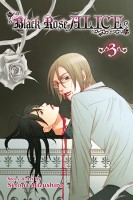 Black Rose Alice, Volume 3 by Setona Mizushiro. After a brief detour into lighter territory in the second volume, the third volume Black Rose Alice has taken a definite turn for the darker again. The series can be legitimately disconcerting and oddly provocative at the same time. Alice is getting to know all of the vampires in the nest a little better, but it’s Leo who is in the lead for her affections. The twins are somewhat immature and Dimitri is intentionally trying to not get involved with her, so Leo seems to be Alice’s obvious choice for procreation. Going through with it will lead to both of their deaths, so she is taking her time in making the decision, wanting to feel confident that her choice is the correct one. However, time is not on Leo’s side; his death is already imminent. Alice is unaware of this, though she does notice him acting out-of-character. Black Rose Alice is a strange and disturbing series. As a whole the vampire mythology that Mizushiro has created continues to be unlike any other that I’ve encountered. There is a very dark eroticism to the story as well. Occasionally there are more humorous moments, but they only serve to emphasize the underlying horror of the series.
Black Rose Alice, Volume 3 by Setona Mizushiro. After a brief detour into lighter territory in the second volume, the third volume Black Rose Alice has taken a definite turn for the darker again. The series can be legitimately disconcerting and oddly provocative at the same time. Alice is getting to know all of the vampires in the nest a little better, but it’s Leo who is in the lead for her affections. The twins are somewhat immature and Dimitri is intentionally trying to not get involved with her, so Leo seems to be Alice’s obvious choice for procreation. Going through with it will lead to both of their deaths, so she is taking her time in making the decision, wanting to feel confident that her choice is the correct one. However, time is not on Leo’s side; his death is already imminent. Alice is unaware of this, though she does notice him acting out-of-character. Black Rose Alice is a strange and disturbing series. As a whole the vampire mythology that Mizushiro has created continues to be unlike any other that I’ve encountered. There is a very dark eroticism to the story as well. Occasionally there are more humorous moments, but they only serve to emphasize the underlying horror of the series.
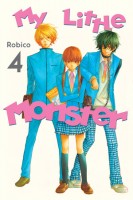 My Little Monster, Volumes 4-6 by Robico. The third volume back-pedaled from the progress that the story and characters had made in the first two volumes and now with these three it seems as though My Little Monster is stuck in some sort of mire. I still like the characters, most of whom are quirky or weird in one way or another, but I find it immensely frustrating that the series just isn’t going anywhere. Actually, other than the awkward romance, I’m not entirely sure what the overarching story is even supposed to be at this point. However, there is definitely one heck of a love polygon going on. But even with so many unrequited feelings, there doesn’t seem to be as much drama as would be expected. In some ways, that’s actually a little refreshing. It’s nice that the characters can enjoy one another’s company even considering the romantic rivalries. I am glad to see that Haru’s volatile and frequently violent emotional state hasn’t been romanticized, although occasionally it is used for a bit of humor. In part, My Little Monster is intended to be a comedy, but these volumes are generally a bit more serious overall. There are still some genuinely funny and endearing moments, though.
My Little Monster, Volumes 4-6 by Robico. The third volume back-pedaled from the progress that the story and characters had made in the first two volumes and now with these three it seems as though My Little Monster is stuck in some sort of mire. I still like the characters, most of whom are quirky or weird in one way or another, but I find it immensely frustrating that the series just isn’t going anywhere. Actually, other than the awkward romance, I’m not entirely sure what the overarching story is even supposed to be at this point. However, there is definitely one heck of a love polygon going on. But even with so many unrequited feelings, there doesn’t seem to be as much drama as would be expected. In some ways, that’s actually a little refreshing. It’s nice that the characters can enjoy one another’s company even considering the romantic rivalries. I am glad to see that Haru’s volatile and frequently violent emotional state hasn’t been romanticized, although occasionally it is used for a bit of humor. In part, My Little Monster is intended to be a comedy, but these volumes are generally a bit more serious overall. There are still some genuinely funny and endearing moments, though.
 Not Enough Time by Shoko Hidaka. Because I’m enjoying her ongoing series Blue Morning so much, and to make the wait for the next volume a little easier, I’ve made a point to read more of Hidaka’s manga. Not only was Not Enough Time Hidaka’s debut in English, it was also her first volume of boys’ love manga to be released in Japan. Even though it’s an early work, Hidaka’s storytelling and nuanced characterizations were already quite excellent. Her artwork is lovely, too. Not Enough Time is a collection of six short boys’ love manga, some of which share a few recurring characters while others are completely unrelated. One lead couple consists of two high school students, but all of the other romances in the volume are between adult men. The basic settings and overall scenarios of the stories collected in Not Enough Time aren’t particularly unusual or unique. What makes them stand out is Hidaka’s willingness to allow the relationships to be complicated and messy; the endings aren’t always wrapped up happily or neatly. Instead, there is a sense of ambiguity and the feeling that characters’ lives continue on well after the manga has concluded. I thoroughly enjoyed the collection.
Not Enough Time by Shoko Hidaka. Because I’m enjoying her ongoing series Blue Morning so much, and to make the wait for the next volume a little easier, I’ve made a point to read more of Hidaka’s manga. Not only was Not Enough Time Hidaka’s debut in English, it was also her first volume of boys’ love manga to be released in Japan. Even though it’s an early work, Hidaka’s storytelling and nuanced characterizations were already quite excellent. Her artwork is lovely, too. Not Enough Time is a collection of six short boys’ love manga, some of which share a few recurring characters while others are completely unrelated. One lead couple consists of two high school students, but all of the other romances in the volume are between adult men. The basic settings and overall scenarios of the stories collected in Not Enough Time aren’t particularly unusual or unique. What makes them stand out is Hidaka’s willingness to allow the relationships to be complicated and messy; the endings aren’t always wrapped up happily or neatly. Instead, there is a sense of ambiguity and the feeling that characters’ lives continue on well after the manga has concluded. I thoroughly enjoyed the collection.
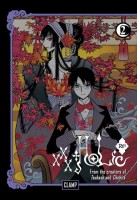 xxxHolic: Rei, Volume 2 by CLAMP. After two volumes, I’m not yet convinced that CLAMP knows exactly where Rei is going as it feels a bit aimless. I find that I’m much less interested in the episodic stories of the series than I am in its underlying plot. Only ominous hints are given as to what is going on, just enough to keep the manga engaging. Watanuki is as clueless as the readers are at this point (if not more so), though he is becoming increasingly suspicious about his precarious situation. Both Yuko and Domeki obviously know what is what, but they either can’t or won’t tell him. Rei may be somewhat haphazard story-wise, but I really do enjoy the series’ striking artwork. It might not be absolutely necessary to have read xxxHOlic to follow Rei, but I do get the feeling that the manga will be more meaningful to those who have at least passing familiarity with the original series. (I should actually get around to finishing xxxHolic one of these days, especially now that it’s back in print; I’ve only ever read the first few volumes or so.) I’m very curious to see how Rei ties back into xxxHolic proper, or if it ever does. The third volume of Rei has been released in Japan, but apparently the series is currently on hiatus.
xxxHolic: Rei, Volume 2 by CLAMP. After two volumes, I’m not yet convinced that CLAMP knows exactly where Rei is going as it feels a bit aimless. I find that I’m much less interested in the episodic stories of the series than I am in its underlying plot. Only ominous hints are given as to what is going on, just enough to keep the manga engaging. Watanuki is as clueless as the readers are at this point (if not more so), though he is becoming increasingly suspicious about his precarious situation. Both Yuko and Domeki obviously know what is what, but they either can’t or won’t tell him. Rei may be somewhat haphazard story-wise, but I really do enjoy the series’ striking artwork. It might not be absolutely necessary to have read xxxHOlic to follow Rei, but I do get the feeling that the manga will be more meaningful to those who have at least passing familiarity with the original series. (I should actually get around to finishing xxxHolic one of these days, especially now that it’s back in print; I’ve only ever read the first few volumes or so.) I’m very curious to see how Rei ties back into xxxHolic proper, or if it ever does. The third volume of Rei has been released in Japan, but apparently the series is currently on hiatus.

